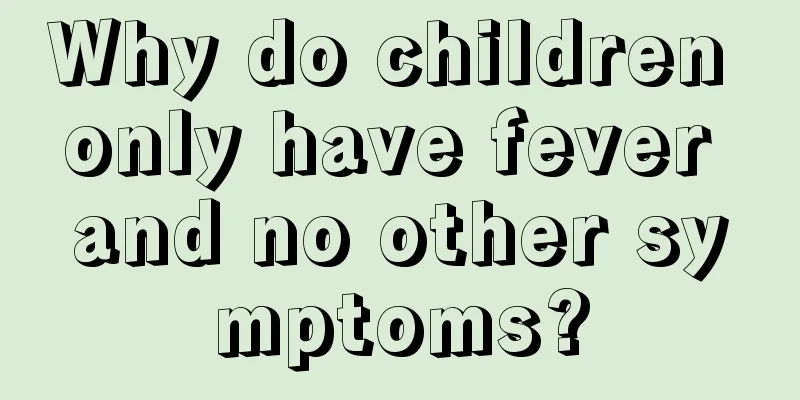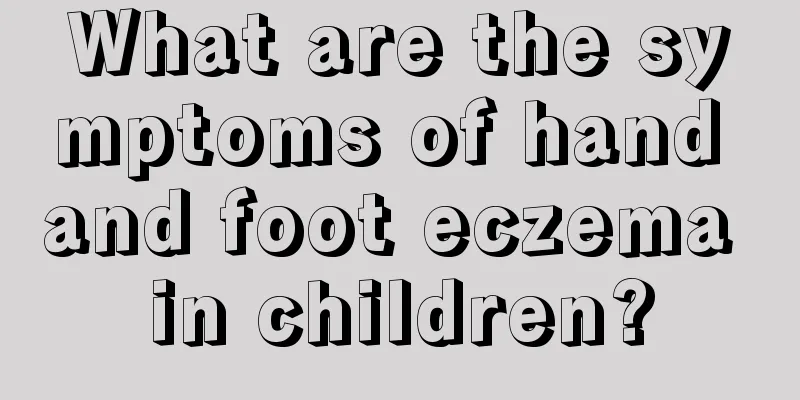Why do children only have fever and no other symptoms?

|
Fever often occurs after a cold, so it is not wrong to say that colds and fever go hand in hand. However, some parents said that they didn't know why their children only had symptoms of fever and no other abnormalities. If you say it is a disease, it doesn't seem like it. If you say it is not a disease, the baby's body temperature is beyond the normal range. So, why do children only have fever without other symptoms? Causes 1. Short-term fever (fever < 2 weeks) Short-term fever in pediatrics is mostly caused by infection, and generally has a good prognosis or is a self-limited disease. However, fever may also be an early manifestation of critically ill children, especially children with severe symptoms of poisoning such as mental depression, drowsiness, and pale complexion. Attention should be paid to the child's medical history, history of contact with infectious diseases, and the presence or absence of symptoms and signs of respiratory, digestive, urinary, nervous and other systems, as well as the presence or absence of rash, petechiae, jaundice, anemia, lymphadenopathy, hepatosplenomegaly, and local infection foci. 2. Long-term fever (fever ≥ 2 weeks) (1) Infectious fever 1) Respiratory system infections are the most common, with pathogens including viruses, mycoplasmas, bacteria and tuberculosis; 2) Other system infections Intestinal infection, urinary tract infection, central nervous system infection (encephalitis, meningitis), cardiovascular system infection (such as infective endocarditis, pericarditis), hepatobiliary system infection (such as hepatitis, cholangitis, liver abscess, etc.); 3) Systemic infection Such as sepsis, tuberculosis, typhoid, paratyphoid, typhus, brucellosis, Epstein-Barr virus infection, cytomegalovirus infection, Lyme disease, leptospirosis, malaria, kala-azar, schistosomiasis and fungal infection, etc.; 4) Abscess or localized infection such as osteomyelitis, perinephric abscess, subphrenic abscess, appendiceal abscess, perianal abscess, etc. (2) Non-infectious fever 1) Rheumatic diseases Juvenile rheumatoid arthritis is the most common. In recent years, as streptococcal infections have been promptly controlled, rheumatic fever has become less common. Other rheumatic diseases that cause fever include systemic lupus erythematosus, polyarteritis nodosa, Kawasaki disease, serum sickness, dermatomyositis, nodular nonsuppurative panniculitis, Wegener's malignant granulomatosis, and angioimmunoblastic lymphadenopathy. 2) Tissue destruction or necrosis Malignant tumors, with leukemia being the most common, and others include malignant lymphoma (including Hodgkin's and non-Hodgkin's lymphoma), neuroblastoma, malignant histiocytosis, Langerhans' histiocytosis and Ewing's sarcoma, etc.; large-area burns, after major surgery, internal bleeding absorption process, vascular embolism, etc. 3) Excessive heat generation or reduced heat dissipation Excessive heat production is seen in hyperthyroidism, status epilepticus, and hyperadrenocortical function; reduced heat dissipation is seen in generalized dermatitis, massive water loss, blood loss, heat stroke, congenital ectodermal dysplasia, and excessive wrapping of newborns. 4) Diseases of the hypothalamic temperature regulation center such as skull injury, cerebral hypoplasia, intracranial tumors, subarachnoid hemorrhage, heat stroke, toxic encephalopathy, sequelae of encephalitis and diencephalic lesions. 5) Autonomic dysfunction such as functional hypothermia and chronic nonspecific lymphocytosis. 6) Other drug fever, drug poisoning (such as salicylic acid, atropine), blood transfusion or infusion reaction, hypernatremia (pituitary or nephrogenic diabetes insipidus), inflammatory bowel disease and immunodeficiency disease, etc. 3. Chronic low fever (long-term low fever) It refers to a patient with a slow onset, a body temperature between 37.5 and 38.0°C, and a duration of more than 4 weeks. 40% were infectious fevers, 57% were non-infectious fevers, and 3% were of unknown cause. First, tuberculosis, including pulmonary tuberculosis, should be excluded; chronic low-grade fever is often caused by infection, such as post-streptococcal syndrome and other post-infectious fever, and the presence of chronic lesions or small abscesses should be sought, such as chronic crypt tonsillitis, lymphadenitis, sinusitis, dental caries, gingival abscesses, perianal abscesses, etc. Non-infectious diseases of chronic low fever include hyperthyroidism, diabetes insipidus, rheumatic diseases, inflammatory bowel disease (Crohn's disease and ulcerative colitis), blood diseases, summer fever, excessive protein intake and prolonged temperature testing. Excluding the above causes, if the cause of low fever still cannot be found, but the child does not have any illness, only follow-up observation is needed, and the low fever can return to normal on its own after a few weeks. |
<<: What happens if children have blood in their sputum?
>>: What are the symptoms of excessive liver fire in children?
Recommend
How to treat a two-month-old child with a cold and fever?
Children are usually susceptible to various disea...
Signs of low IQ in children
Human thinking is maintained through intelligence...
Home care for hemolytic disease of the newborn
Neonatal hemolytic disease is a neonatal blood di...
What should I do if my three-year-old child still drools?
Many people say that it is natural for children t...
What are the dangers of swimming for newborns?
Today's parents like to let their newborns sw...
Is 37.1 degrees normal for a newborn?
We all know that the temperature is different whe...
Why does a child sweat while sleeping?
Some parents sometimes find that their children s...
Solutions for children's stuffy nose when sleeping at night
In modern society, nasal congestion is a very com...
Causes and treatments for children's bloating
Young mothers will be filled with love and smiles...
Causes and clinical manifestations of external hydrocephalus
The baby's physical health is an issue that p...
When is the best time for children to supplement zinc?
In our daily life, we eat a lot of food every day...
Are swollen lymph nodes in the neck benign or malignant?
Swollen lymph nodes in the baby's neck are mo...
Symptoms of parasite infection in babies
It is very common for babies to have parasites in...
Acupoint massage method for children with fever
The method of degree massage to relieve children&...
What are the benefits of children learning to swim?
In daily life, many children like to play with wa...









